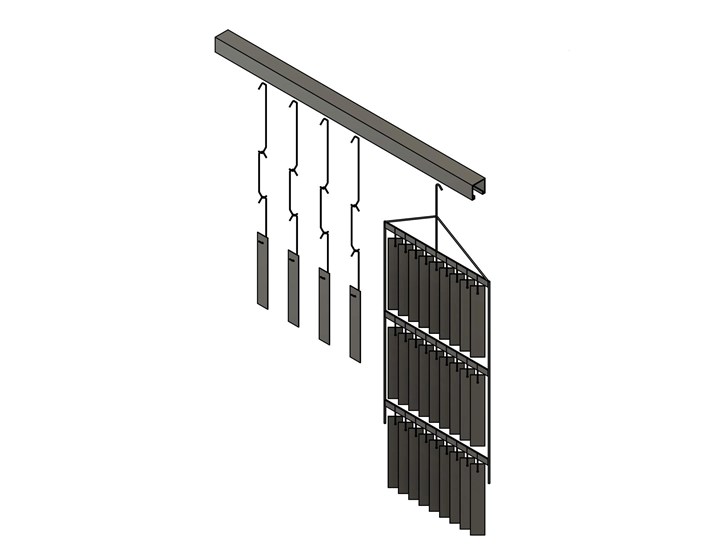The Real Cost: C-Hooks Versus Parts Racks
Industrial finishing line consultant Dan Davitz discusses the advantages of parts rack over the use of C-hooks for your paint or powder coating line.
Q: I’m on the fence about investing in racking. I know I can gain efficiency, but is it worth the investment?
A: It’s human nature, when given a job to do, that we immediately look for the fastest way to get it done. If we’re conscientious about our work and there’s more than one way to do the job, we’ll evaluate the speed, quality and overall cost for each method to make a wise decision. However, when it comes to finishing lines, many managers assume that as long as the line is moving and there are parts visibly hanging on it, the job is getting done, and done right. They assume that their method for getting parts on their line, “…just grab some C-hooks and start hanging…”, is the wisest and most cost-effective method, when if the operations were properly examined, they would find that more often than not, racking parts is far more efficient and profitable than using C-hooks. With more than 30 years of experience, I’ve seen the best finishing line managers running the fastest and most productive lines always use parts racks versus C-hooks to hang their parts. While observing finishing lines, I am constantly amazed to see so much wasted line space and labor being spent using C-hooks to hang parts, versus using racks which will produce far more parts in less time, with less labor, and for less money. The bottom line — when choosing to use C-hooks when racks can be utilized, is a decision that comes with a high price.
When quoting the price for finishing a part, there’s a labor charge for every handling operation. Years ago, the charge was approximately $0.35, and today it can be as much as $0.60 each time a part or hook is handled. And whether it’s recognized or not, every time a person has to locate and grab a C-hook or multiple C-hooks just to hang a part, there’s a cost for labor associated with that handling operation(s). Depending on the size of the part, the location of the hang holes, the number of hooks required to hold the part properly, and the type of C-hooks needed (parallel versus 90-degree ends), often multiple C-hooks are used to “daisy-chain” like monkeys from one hook to another and one part to another. I recently saw an entire conveyor filled by daisy-chaining three C-hooks together vertically, just to hang one 12" x 2" flat piece of sheet metal from the conveyor every six (6) inches. The person loading the parts handled three C-hooks plus the part — four (4) separate handling operations per piece. Contrast this with using pre-configured racks where the individual parts hooks are already attached to the rack in a stationary fashion. At this point, only the part itself is touched (or hung) — only one (1) handling operation per piece — no parts hooks are touched or handled by the person loading parts. Once the rack is pre-hung on the line at the beginning of a part’s run, it remains on the line until the run is complete. Afterward, the racks and hooks may or may not be reconfigured for other parts. In summary, utilizing racks saves considerable costs in labor by eliminating the handling of C-hooks.

575% or 6.75 times increased production yield using racks versus C-hooks
Photo Credit: Prism Strategy & Design LLC
Additionally, if a part is small enough to require multiples to fill the vertical paint window, often the parts are daisy-chained from one another using additional C-hooks by attaching to the bottom of a previously hung part in order to hang the next part below it, resulting in additional handling of C-hooks at the bottom of every part — adding additional costs in labor for every piece. Moreover, if there aren’t enough holes in the parts, and in the right places to attach another set of C-hooks for daisy-chaining another part, then the person loading parts has no choice but to hang only one part and waste valuable left-over space in the vertical paint window. In the example above, the vertical paint window was large enough to handle at least three (3) parts deep. Thus, by utilizing a 3-tier rack with stationary hooks on 2" centers horizontally on a 45-degree angle, both the vertical and horizontal parts density combined could increase the parts yield by an estimated 6.75 times or 575%. See illustration.
Another vital consideration that is often overlooked when using C-hooks and applying paint electrostatically, or any application requiring an electrical ground, is the increased risk of losing the ground contact from the conveyor to the part, particularly when C-hooks are daisy-chained from one to another. When daisy-chaining C-hooks, each added connection is dependent upon the previous one for the electrical ground. If the ground connection is lost at the top by just one hook end with paint build-up insulating the ground contact, the entire string of hooks and parts underneath are also without ground. The grounding is further jeopardized as the C-hooks are constantly moving with the motion of the line and swinging parts. The loss of electrical ground affects both the efficiency and the quality of the paint application. Contrast this with using racks where the ground is maintained from the conveyor hook at the top of the rack proceeding down through a fixed metal frame to each individual stationary hook — not swinging — carrying the ground directly to the part. It’s important to note that regular cleaning is required whether using C-hooks or racks and that parts racks usually require a greater investment of time and equipment in the cleaning process. However, the benefits gained from parts racks as detailed above, more than pay for the additional investment.
In conclusion, utilizing racks instead of C-hooks requires good management to maximize parts density and thereby yielding increased production. But, as the most successful finishing line managers have found, taking the time to utilize proper parts racking will pay for the investment many times over. The savings in labor costs by eliminating the handling of C-hooks, added to the increased parts density both vertically and horizontally in the same space on the line yielding increased efficiency of paint usage, utilities, and chemicals, in addition to the improved grounding and quality of the finished parts, will always far outweigh the investment of proper racking. Run the numbers and see for yourself what racking parts can do for you and your company’s bottom line.
About the Author

Dan Davitz
Dan Davitz is founder and independent consultant at Prism Strategy & Design, LLC. For more information email: Info@PrismStrategyAndDesign.com
Related Content
FABTECH 2024 Heads to Orlando
CCAI’s FINISHING Pavilion and Conference continues to grow at FABTECH, offering insights and innovations covering all aspects of industrial surface finishing.
Read MoreMaximize Your Racking Efficiency and Quality
Best practices for racking parts in surface finishing operations.
Read MoreChicago-Based Anodizer Doubles Capacity, Enhancing Technology
Chicago Anodizing Company recently completed a major renovation, increasing its capacity for hardcoat anodizing and Type II anodizing.
Read MoreFilm Thickness Control
Have a powder coating job that requires precise film thickness control? Products Finishing columnist Rodger Talbert offers advice controlling the variables that can impact your success.
Read MoreRead Next
A ‘Clean’ Agenda Offers Unique Presentations in Chicago
The 2024 Parts Cleaning Conference, co-located with the International Manufacturing Technology Show, includes presentations by several speakers who are new to the conference and topics that have not been covered in past editions of this event.
Read MoreEducation Bringing Cleaning to Machining
Debuting new speakers and cleaning technology content during this half-day workshop co-located with IMTS 2024.
Read MoreDelivering Increased Benefits to Greenhouse Films
Baystar's Borstar technology is helping customers deliver better, more reliable production methods to greenhouse agriculture.
Read More





















